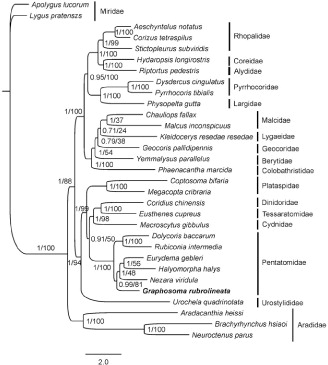Abstract
Here, we determined the complete mitogenome of Graphosoma rubrolineata, as the first representative for the subfamily Podopinae. This mitogenome is 15,633 bp long and contains 37 typical mitochondrial genes. The genome size, gene arrangement, A + T content, codon usage and secondary structures of 22 tRNAs of the G. rubrolineata mitogenome were similar to that of other sequenced pentatomoids. This mitogenome exhibited a reverse nucleotide strand bias, i.e. positive GC-skew (0.021) and negative AT-skew (−0.086). Phylogenetic analyses based on mitogenomic data strongly supported the monophyly of each of the five superfamilies within Pentatomomorpha and recognized a phylogeny of (Aradoidea + (Pentatomoidea + (Lygaeoidea + (Pyrrhocoroidea + Coreoidea)))). However, G. rubrolineata clustered with three Pentatominae species, suggesting that Pentatominae probably was not monophyletic, or Podopinae may not be a valid taxonomic group. The mitogenome sequence of G. rubrolineata could contribute for better understanding of population genetics and evolution of this insect pest.
Pentatomidae is one of the most diverse groups in Heteroptera and of great economic importance (Rider Citation2011). To date, all the five pentatomid mitogenomes are from Pentatominae, which limits our understanding on the diversity and phylogeny of Pentatomidae. Here, we determined the complete mitogenome of Graphosoma rubrolineata, an important pest on vegetables and medicinal herbs in China. Adult specimens of G. rubrolineata were collected from Qingyang City, Gansu Province, China, in July 2015. Samples have been deposited in the State Key Laboratory of Grassland Agro-Ecosystems, College of Pastoral Agricultural Science and Technology, Lanzhou University, Lanzhou, China.
This mitogenome was a typical circular DNA molecule with 15,633 bp in length (GenBank accession no. KX267740) and contained 37 typical mitochondrial genes: 13 protein-coding genes (PCGs), 22 transfer RNA genes (tRNAs), the large and small ribosomal RNA unit genes (rrnL and rrnS). All genes were arranged in the same order as the inferred insect ancestral mitogenome (Boore Citation1999). The nucleotide composition of the G. rubrolineata mitogenome was significantly biased towards A and T, with a 74.98% A + T content in average. This mitogenome presented a negative AT-skew (−0.086) and a positive GC-skew (0.021), which was contrary to that of most insect mitogenomes. 10 PCGs started with a typical ATN codon and the remaining three PCGs (cox1, atp8, and nad1) began with TTG. Eight PCGs terminated with TAA, four terminated with an incomplete stop codon T––, whereas nad4 terminated with TAG, another frequently used stop codon in insect mitogenomes.
All of the 22 tRNAs had a typical cloverleaf structure, except for trnS1 (AGN) in which its dihydrouridine arm simply formed a loop. In addition, trnS1 in the G. rubrolineata mitogenome presented an unusual anticodon stem (9 bp vs. the normal 5 bp) and a bulged nucleotide in the middle of the AC stem, which was a common feature in true bugs (Zhang et al. Citation2013; Yuan et al. Citation2015a, Citation2015b). The rrnL was 1277 bp long with an A + T content of 78.8%, and the rrnS was 796 bp with an A + T content of 77.5%.
Figure 1. Mitochondrial phylogeny of 29 Pentatomomorpha species based on the concatenated nucleotide sequences of 13 mitochondrial protein-coding genes. Bayesian inference and maximum-likelihood analyses recover the same three topology. Numbers on branches are Bayesian posterior probabilities (left) and bootstrap values (right).

Phylogenetic analyses of 29 Pentatomomorpha species with Bayesian inference and maximum-likelihood methods using the concatenated nucleotide sequences of 13 mitochondrial PCGs resulted in identical tree topology (). The monophyly of each of the five superfamilies was highly supported and a phylogeny of (Aradoidea + (Pentatomoidea + (Lygaeoidea + (Coreoidea + Pyrrhocoroidea)))) was recovered, which was consistent with our previous studies (Yuan et al. Citation2015a, Citation2015b). Each of the six families within Pentatomoidae was recovered as monophyletic group and Pentatomidae was more closely related to Cydnidae. Although G. rubrolineata was from the subfamily Podopinae, this species mixed with species from the subfamily Pentatominae. This suggested that Pentatominae might not be monophyletic, or Podopinae may not be an effective taxonomic category. Therefore, further studies are needed to sequence more species from Podopinae and other subfamilies, which will enhance our understanding of molecular phylogeny in Pentatomidae. This is the first sequenced mitogenome from the subfamily Podopinae and the mitogenomic data of G. rubrolineata could contribute for better understanding of population genetics and evolution of this insect pest.
Disclosure statement
The authors report no conflicts of interest. The authors alone are responsible for the content and writing of the paper.
Additional information
Funding
References
- Rider DA. 2011. Pentatomoidea Home Page [Internet]. North Dakota State University; [cited 2014 Oct 10]. Available from: http://www.ndsu.nodak.edu/ndsu/rider/Pentatomoidea/
- Boore JL. 1999. Animal mitochondrial genomes. Nucleic Acids Res. 27:1767–1780.
- Yuan ML, Zhang QL, Guo ZL, Wang J, Shen YY. 2015a. Comparative mitogenomic analysis of the superfamily Pentatomoidea (Insecta: Hemiptera: Heteroptera) and phylogenetic implications. BMC Genomics. 16:460.
- Yuan ML, Zhang QL, Guo ZL, Wang J, Shen YY. 2015b. The complete mitochondrial genome of Corizus tetraspilus (Hemiptera: Rhopalidae) and phylogenetic analysis of Pentatomomorpha. PLoS One. 10:e0129003.
- Zhang QL, Yuan ML, Shen YY. 2013. The complete mitochondrial genome of Dolycoris baccarum (Insecta: Hemiptera: Pentatomidae). Mitochondrial DNA. 24:469–471.
